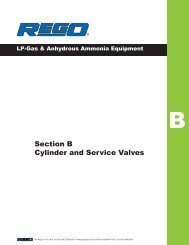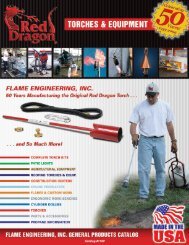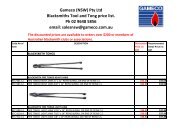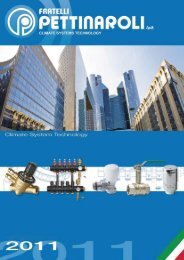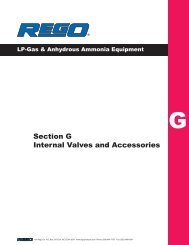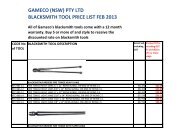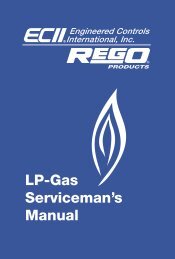You also want an ePaper? Increase the reach of your titles
YUMPU automatically turns print PDFs into web optimized ePapers that Google loves.
LP-Gas Regulators<br />
Safety Warnings<br />
Purpose<br />
In its continuing quest for safety, Engineered Controls International, Inc. publishes a series of bulletins explaining<br />
the hazards associated with the use, misuse, and aging of LP-Gas valves and regulators. It is hoped that these<br />
factual bulletins will make clear to LP-Gas dealer managers and service personnel, that the utmost care and<br />
attention must be used in the installation, inspection, and maintenance of these products, or problems could<br />
occur which would result in injuries and property damage.<br />
The National Fire Protection Association Pamphlet #58 - 2001 Edition, “Liquified Petroleum Gas Code” states in<br />
Section 1.5 that, “persons who transfer liquid LP-Gas, who are employed to transport LP-Gas, or whose primary<br />
duties fall within the scope of this code shall be trained in proper handling procedures. Refresher training shall<br />
be provided at least every three years. The training shall be documented.” These “ECII® Safety Warnings”<br />
may be useful in training new employees and reminding older employees of hazards that can occur. It is<br />
recommended that all employees be furnished with a copy of NPGA Safety Pamphlet 306, “LP-Gas Regulator<br />
and Valve Inspection and Maintenance.”<br />
Nature of Warnings<br />
It is recognized that warnings should be as brief as possible, but<br />
the factors involved in regulator failures are not simple. They need<br />
to be fully understood so that proper maintenance programs can be<br />
established. If there is a simple warning, it would be:<br />
Inspect regulators regularly as outlined in this safety warning and<br />
replace as required per these recommendations. When all of these<br />
recommendations are followed, the recommended service life of<br />
an ECII/RegO® regulator (except single stage) manufactured after<br />
1995 is 25 years. The recommended service life of all other ECII/<br />
RegO® regulators is 15 years.<br />
The Causes of High Pressure Gas in a System are:<br />
1. Regulator vents that are clogged or obstructed.<br />
Vents must be clear and fully open at all times.<br />
Many regulators are equipped with a pressure relief valve which<br />
discharges to atmosphere through the vent. Ice, snow drifts, dirt, bugs,<br />
paint, or other foreign material can clog the vents.<br />
An obstructed vent may prevent the pressure relief valve from<br />
operating properly.<br />
LP-Gas Regulators<br />
This bulletin applies most particularly to permanent LP-Gas<br />
installations of cylinders and tanks. The warnings also apply in most<br />
cases to portable installations of recreational vehicles, barbecue grills,<br />
etc.<br />
This bulletin is not intended to be an exhaustive treatment of<br />
the subject of regulators and certainly does not cover all<br />
safety practices that should be followed in the installation and<br />
maintenance of LP-Gas systems.<br />
Large Vent<br />
It should not be necessary to remind readers of this bulletin that<br />
regulators must be installed in strict conformance with NFPA<br />
Pamphlets 54 and 58, and all other applicable codes and regulations.<br />
Codes, regulations and manufacturer’s recommendations have been<br />
developed by experts with many years of experience in the LP-Gas<br />
industry.<br />
Failure to fully follow these codes, regulations and<br />
recommendations could result in hazardous installations.<br />
Pamphlet 58 states “All regulators for outdoor installations, except<br />
regulators used for portable industrial applications, shall be designed,<br />
installed or protected so their operation will not be affected by<br />
the elements (freezing rain, sleet, snow, ice, mud or debris). This<br />
protection may be integral with the regulator.”<br />
Failed and/or Inoperative Regulators<br />
Failed regulators can cause three kinds of hazards:<br />
• High pressure LP-Gas in a system downstream of the regulator; and<br />
• Leaks of LP-Gas to atmosphere from the regulator itself.<br />
• Loss of pressure due to a “freeze-up” in the orifice.<br />
High Pressure LP-Gas in a System<br />
Regulators should be installed with the vent facing down or protected<br />
so their operation will not be affected by the elements. In cases where<br />
the regulator vent is equipped with a discharge tube, the outlet of this<br />
tube must be facing down. The vents and/or discharge tubes must be<br />
protected from the elements and must be equipped with a screen to<br />
prevent bugs from obstructing the opening.<br />
Action Required: Regulators should be properly installed and<br />
regularly inspected when tanks or cylinders are filled. If vents are<br />
clogged or the screen is missing, they must be cleaned or replaced.<br />
If the vent screen is missing and there is evidence of foreign material<br />
around the vent, the regulator should be replaced.<br />
2. Foreign material lodging between the regulator nozzle and seat<br />
disc:<br />
When this occurs, the regulator can remain open, allowing high<br />
pressure gas into the system.<br />
Anything that prevents a regulator from regulating properly could result<br />
in high pressure gas at the regulator outlet and thus in a system.<br />
High pressure gas into piping and appliances could cause piping<br />
leaks and damage to appliance burner controls with the potential<br />
for fires and explosions.<br />
4<br />
Regulators & Accessories<br />
®



